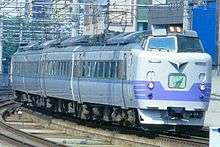Suzuran
The Suzuran (すずらん) is a limited express train service operated by Hokkaido Railway Company (JR Hokkaido) between Muroran and Sapporo in Hokkaido, Japan.[1] The current limited express service was introduced in July 1992, but the name was first used from 1956 for an express service operated by JNR between Hakodate and Sapporo.[2] Suzuran is Japanese for Lily of the valley.
 785 series EMU on a Suzuran service at Muroran Station, October 2007 | |
| Overview | |
|---|---|
| Service type | Limited express |
| Locale | Hokkaido |
| First service | 1956 (Express) July 1992 (Limited express) |
| Current operator(s) | JR Hokkaido |
| Former operator(s) | JNR |
| Route | |
| Start | Sapporo |
| End | Muroran |
| On-board services | |
| Class(es) | Standard class only |
| Technical | |
| Rolling stock | 789-1000 series & 785 series EMUs |
| Track gauge | 1,067 mm (3 ft 6 in) |
| Electrification | 20 kV AC overhead |
| Operating speed | 130 km/h (80 mph) |
Rolling stock
Services are formed of 5-car 785 series and 789-1000 series EMUs. All seats are non-reserved, except for car 4, which has improved "u-Seat" accommodation, including AC outlets for personal use.[1][3]
- A 789-1000 series EMU, January 2009
- 785 series non-reserved seating, May 2008
- 785 series reserved "u-Seat" car, August 2007
- 789-1000 series non-reserved seating, May 2008
 789-1000 series reserved "u-Seat" car, September 2007
789-1000 series reserved "u-Seat" car, September 2007
Formations
Trains are formed as shown below, with car 1 at the Muroran end.[3][4]
| Car No. | 1 | 2 | 3 | 4 | 5 |
|---|---|---|---|---|---|
| Accommodation | Non-reserved | Non-reserved | Non-reserved | Reserved (u-Seat) | Non-reserved |
| Facilities | Toilet | Wheelchair space, toilet | Toilet |

From July 1992 until 30 September 2007, Suzuran services were formed of 4-car 781 series EMUs, with one reserved car (car 4), formed as shown below.[5][6]
| Car No. | 1 | 2 | 3 | 4 |
|---|---|---|---|---|
| Accommodation | Non-reserved | Non-reserved | Non-reserved | Reserved |
| Facilities | Toilet | Vending machine | Telephone, toilet |
References
- JR Timetable, December 2008
- JR新幹線&特急列車ファイル [JR Shinkansen & Limited Express Train File]. Japan: Kōtsū Shimbun. 2008. p. 86. ISBN 978-4-330-00608-6.
- 列車名鑑1995 [Train Name Directory 1995]. Japan: Railway Journal. August 1995.
- JR Timetable, August 2011 issue, p. 1002
- JR電車編成表 2012冬 [JR EMU Formations - Winter 2012]. Japan: JRR. October 2011. pp. 2–3. ISBN 978-4-330-25611-5.
- こだわりの新幹線&特急列車ガイド [In-depth Shinkansen & Limited Express Guide]. Japan: Ikaros Publishing. August 2000. p. 53. ISBN 4-87149-284-2.
- JR電車編成表 '05冬号 [JR EMU Formations - Winter 2005]. Japan: JRR. January 2005. p. 3. ISBN 4-88283-042-6.
External links
| Wikimedia Commons has media related to Suzuran. |
- JR Hokkaido Suzuran train information (in Japanese)